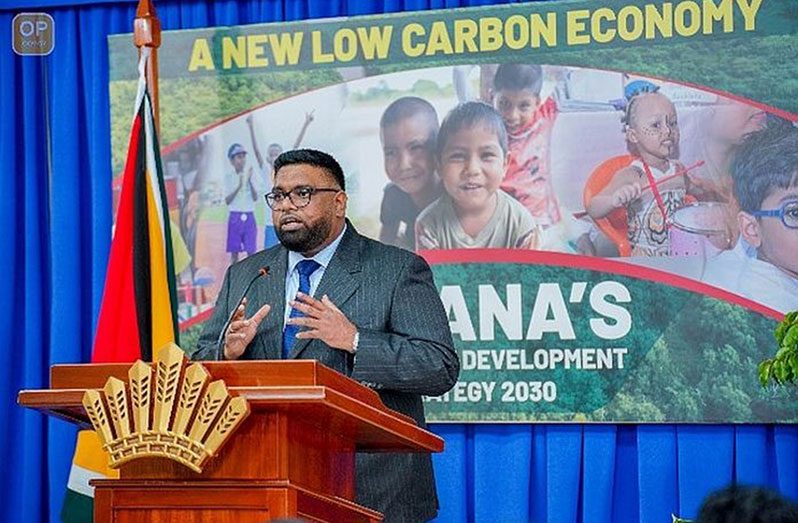“THE Low Carbon Development Strategy (LCDS) is a framework intended to map the path of a new growth trajectory in a non-polluting way. Tropical-forest countries have long called for the ecosystem services provided by the world’s standing tropical forests to be properly valued through both public and private finance. This will enable people who live in forests and forest countries to create jobs and economic opportunity from an economy that works with nature, instead of today’s reality, where forests are often worth more dead than alive.” — H.E. Dr Bharrat Jagdeo, former President of Guyana (2009).
Like most low-lying coastal states, Guyana is open to the devastating impacts of climate change. Climate change is the most critical global environmental problem of our time and the single greatest challenge facing environmental regulators. It is a growing crisis with economic, health and safety, food production, security, and other dimensions. If global warming continues, our low-lying coastlands and their entire infrastructure, settlements, and agriculture stand to be devastated by sea-level rise and extreme weather events. Furthermore, our country is at a critical crossroad: we are a developing country and have limited resources for economic development. However, these very resources are needed to save the world from the disastrous effects of a changing climate.
The Low Carbon Development Strategy 2030 sets out a vision for rising to the challenge. The LCDS 2030 also sets out how we can build a platform for the economy of the future, a low-carbon economy, where our world-class forests, biodiversity, water and marine resources are valued for the vital contribution they make to the health of our planet.

What does the LCDS mean to me?
While most of Guyana’s population lives on the coast, the services offered by our tropical rainforests and other ecosystems which are out of sight are numerous and beneficial – from providing fresh water, to helping keep the global climate stable, to providing opportunities for advances in medicine and income-generating activities in the tourism, forestry, and agricultural sectors. In fact, for the period 2009 to 2015, Guyana earned US$212.52 million in payments to be invested in the LCDS. This has created low-carbon jobs, enabled Amerindian villages to receive a legal title for communal lands, rehabilitated the Cunha Canal to protect against flooding, and started to equip Amerindian and hinterland communities with renewable energy, digital infrastructure, and sustainable livelihood opportunities.
Did you know?
Guyana’s forests alone provide value that is estimated to range from US$40-US$54 billion annually.

How it started
The LCDS was launched on June 08, 2009, with the revised version being published on May 24 2010, and subsequently was launched on March 2013. The new draft continues to propel Guyana on a pathway started in 2008, when we were the world’s first developing country to publish a Low Carbon Development Strategy. Our country believes that we can protect and maintain its forests in the effort to reduce global carbon emissions and at the same time attract resources for our country to grow and develop. In order to do this effectively in the long term, we need a clear vision and a plan of how to get there. This vision and plan were titled the Low Carbon Development Strategy (LCDS).
The three objectives set out in 2009 continue to provide a guiding framework and have been enhanced, based on knowledge gained since then, as well as new opportunities created by international progress.
• Forest Climate Services and other Ecosystem Services
• Stimulate future growth through clean energy and sustainable economic activities
• Protect against climate change
Guyana’s Low-Carbon Development Strategy 2030 creates new incentives within the economic sectors, namely, fruit and vegetable farming, aquaculture, sustainable forestry and eco-tourism.
Through Sustainability Planning, for our Forestry, Biodiversity, Water and Ocean/Marine Resources. It also adds a new objective -to align with global climate goals
This means promoting development and stimulating future growth for all Guyana’s people through a balance across:
•Human capital: Ensuring that Guyanese citizens achieve greater health, education and other social outcomes.
•Financial capital: Ensuring equitable access to finance for all, whether seeking to invest in start-ups, expand existing businesses or cope with unexpected external shocks.
•Physical capital: Upgrading Guyana’s energy, transportation, digital, water, and housing infrastructure on a low-carbon, non-polluting trajectory.
•Natural capital: Introducing mechanisms to sustain Guyana’s world-class natural capital to enhance quality of life for all Guyanese and deploy natural capital as part of solutions to global problems, including climate change, biodiversity loss and deteriorating water resources.

Currently, Guyana relies on imported fuel, oil and diesel for its electricity generation, which is both expensive and carbon-intensive. As such the LCDS set out to stimulate future growth: Clean Energy and Low-carbon Development Green Jobs and Sustainable Livelihoods through Clean and Renewable Energy Digital Infrastructure and Low-carbon Transportation.
Further, the LCDS plans to focus on protection against climate change and biodiversity loss, climate adaptation and resilience, while aligning with global climate and biodiversity goals, such as the UN Sustainable Development Goals, etc.
The mandate of the EPA supports the vision and practice outlined in the LCDS by:
* Promoting the value of biodiversity in its education and outreach activities;
* Supporting the sustainable use of natural resources by developing policies, guidelines and regulations; and
* Ensuring that Guyana meets its commitments under the various environmental agreements, for which it has responsibilities.
As Guyanese we should take pride in the scale of vision set out then, and reflect on the significant progress that was made since. We have taken steps to protect the environment and human health, but we do have a long way to go.
You can share your ideas and questions by sending letters to: “Our Earth, Our Environment”, C/O Communications Department, Environmental Protection Agency, Ganges Street, Sophia, GEORGETOWN, or email us at: eit.epaguyana@gmail.com, follow us on Facebook and Instagram, and subscribe to our YouTube channel.



.jpg)








